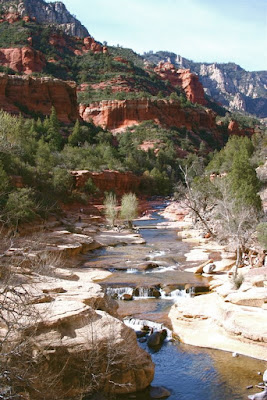Elevation: 4,000 ft
Elevation Gain: None
You would think that our staying within steps of Crescent Moon Park would have tempted us before our last day, but since we had phenomenal views of Cathedral Rock right from our front porch the thought of walking along the creek was not as enticing and you might think.
Still, the park is home to one of the most photographed places in all of Sedona so I knew we would have to make the trek.
Crescent Moon is a picnic area with lovely trees and a creek side walk. The first half of this is paved but the other half is rocky, filled with tree roots, and a few rough areas. I say this from the perspective of my Mother who is not as nimble as she used to be. Anyone under 60 will find the trail quite easy.
 Hoodoos at the far eastern end of the trail. Here one is practically on top of the vortex, which is technically on the other side of the creek. These hoodoos were EVERYWHERE.
Hoodoos at the far eastern end of the trail. Here one is practically on top of the vortex, which is technically on the other side of the creek. These hoodoos were EVERYWHERE.I found out late in our trip that Cathedral Rock is home of one of Sedona's several vortexes (note, I am not misspelling the word, that is how the locals refer to them). These vortexes are supposed to be centers of concentrated earth energy. Lounging or meditating near a vortex is presumably uplifting. It is certainly a more novel tourist attraction than a curio store and it does have the added benefit of getting people outdoors. A little exercise in the sunshine is always uplifting to me.
One document I found online indicated that the vortex near Cathedral Rock was filled with feminine energy. It is supposed to increase one's compassion and empathy. No wonder I had avoided it all week. My father made a snide remark that I would have to hang out at the vortex for a VERY LONG TIME to see any increase in my feminine side.
 Buddha Beach at the end of the trail. Just out of frame to the right was a nice long log for sitting. The hoodoos are also off to the right.
Buddha Beach at the end of the trail. Just out of frame to the right was a nice long log for sitting. The hoodoos are also off to the right.Crescent Moon park is also a mecca for photographers as I have already mentioned. On this last day, I kept wandering over hoping to catch the sunset on the rocks where they are reflected in the water. By the time things were just getting ripe, a swarm of photographers with their tripods staked out plots of gooey mud along the creek bed each hoping I am sure for that quintessential shot. After a entire week of looking up at this admittedly scenic view, I was less enthused about elbowing in. My best shot of the rock was probably taken from our side yard, which incidentally was home to a meditating local for several days while we were there.
I don't know what she was smoking, but she jousted with invisible demons using a tree branch, swayed to and fro on rather unsteady feet, and finally left her shoes behind when she thankfully departed. One can take the whole vortex thing too far.
So this is my final post about my trip to Sedona. I hope you have enjoyed sharing my vacation with me as much as I enjoyed living it. Sedona is a beautiful oasis and I would love to return and hike some of its more challenging trails. Renting a home was a convenient way to share space with several people and it enabled us to cook for ourselves. Some say Sedona is a life-list destination. With so much to do and so much to see, I couldn't agree more.



















































